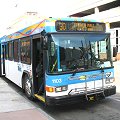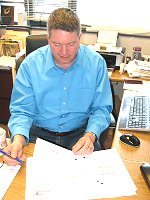- By Patty Poist
- Around Town
 Print
Print  TCAT recently replaced two old diesel buses with new electric-diesel hybrid vehicles and expects to replace 13 other out-of-date buses by the end of 2011.
TCAT recently replaced two old diesel buses with new electric-diesel hybrid vehicles and expects to replace 13 other out-of-date buses by the end of 2011.Thanks to a combination of federal stimulus, state and local funding sources, the replacements will result in lower carbon missions, less maintenance cost and more comfort for both passengers and bus operators, said Dan Tome, TCAT’s purchasing and project manager.
Tome said that the two hybrids, manufactured by California-based Gillig LLC, have increased TCAT’s hybrid fleet to eight. In addition, TCAT will be replacing 13 other old buses by the end of this year with environmentally friendlier diesel buses. Six of those are manufactured by Gillig and the other seven Orion buses are being made by Daimler Buses North America at its Oriskany, N.Y. plant, which is particularly pleasing to Tome.
 Dan Tome“I am excited about all of the new buses, but it is especially gratifying that we were able to buy from Orion as our aim is to retain and secure good-paying manufacturing jobs in New York state,” said Tome, who has been working on the procurement process for two years.
Dan Tome“I am excited about all of the new buses, but it is especially gratifying that we were able to buy from Orion as our aim is to retain and secure good-paying manufacturing jobs in New York state,” said Tome, who has been working on the procurement process for two years.With the 15 new 40-foot replacement buses – at a total cost of nearly $5.5 million – only one of TCAT’s 55 buses will be well past its 12-year useful life.
However, both Tome and Joe Turcotte, TCAT general manager, both said another nine buses will reach their 12-year useful life in 2013 and another nine buses will reach their retirement age in 2014. Given that stimulus money is now dried up and that there is a moratorium on federal earmarks, there is an urgent need for a solid funding structure for replacement buses at transit agencies in New York and across the country.
“A predictable stream of federal funding to replace aging buses is critical to TCAT’s ability to serve a public and a local economy that is becoming more and more dependent on public transit,” said Turcotte, who echoed that same sentiment in his testimony before a U.S. House Transportation and Infrastructure Committee listening session on March 24.
Tome said the six Gillig diesel buses should be arriving by the end of August and the seven Orions should be here by the end of December. Though the new diesels are not hybrids, they adhere to higher emissions standards put into place by the federal government in 2010 that make them almost as easy on the environment as are the hybrids, Tome said. He said better technologies for diesel buses enable the use of an additive that essentially purifies exhaust.
In addition, all the replacement buses have lower floors, which offer more leg room to passengers, Tome said. Overall, the new replacement buses will be more comfortable for passengers and bus operators alike. Steering wheels on all the new buses are more ergonomically friendly as they are equipped with an electrical assistance mechanism that will make it easier for operators to drive, he said.
It’s important to note, Tome said, TCAT will save money in the long run on maintenance costs as it is expensive to continuously repair and maintain old buses.
“We will have fewer break downs and the new buses will be welcomed by our riders who will enjoy state of the art technology and reliability,’’ Tome said. “Bus manufacturers are continuously making buses safer as well, which is important to everyone.”
Tome said the cost of the hybrids is $520,000 a piece. The Gilligs are each $372,000 and the Orions are each $360,000. Of the total cost of $5.48 million dollars, 80 percent is being funded from stimulus or American Recovery and Reinvestment Act (ARRA) money; 10 percent from New York State; and 10 percent from TCAT’s funding partners: Cornell University, Tompkins County and the City of Ithaca.
At the congressional listening session on March 24, Turcotte told the committee that though federal operational funding at around 12 percent has remained steady, but that there is no predictable structure for capital funding to replace older buses. “It doesn’t make good economic sense to keep pumping money into an outdated bus,” Turcotte said.
He noted that TCAT has buses that are more than 20 years old, far surpassing their useful life of 12 years. TCAT, Inc. has been fortunate in the past to receive earmarks to replace buses. Because earmarks are inherently arbitrary – and there is now a congressional moratorium on them – TCAT and other transit agencies are in a precarious position of figuring out ways to keep up with technology and replace buses and other transit equipment.
TCAT last year, for the fourth year in a row, has broken ridership records. In 2010, annual ridership was nearly 3.6 million which “is a huge for a community this size.” TCAT is part of a regional study that could possibly lead to expanded service to serve out-of-county commuters who work in Tompkins County.
At a time when there is a strain on public coffers, TCAT and public transit agencies across the country are now taking more requests for service, particularly as gas prices continue to increase. To be sure, TCAT’s ridership last month jumped by 17.6 percent compared to February of last year due to escalating prices at the pump. That trend is taking place all across the United States, according to the American Public Transportation Association, which predicts that pain at the pump could translate into 1.5 billion additional passenger trips on U.S. public transportation systems.
Turcotte said he understands the need to for fiscal restraint and scrutiny, adding that TCAT is not asking for increases, but predictability. Investing in public transit is crucial to keep the economy as a whole on the path to recovery and federal investment is a positive net gain, he said.
Listening session panelist Rich Ferguson, president and CEO of Daimler Buses North America, which operates the Orion plant in Oriskany, also told the panel that his industry also needs consistency with federal funding. Federal stimulus money for transit agencies to pay for new buses caused a surge in activity and hiring, but after stimulus money was exhausted, business dropped off forcing painful layoffs. In addition, he noted, the bus manufacturing industry has been a leader in guiding energy policy that helps the nation cut down on its dependence on foreign oil by coming up with fuel alternatives.
v7i16



